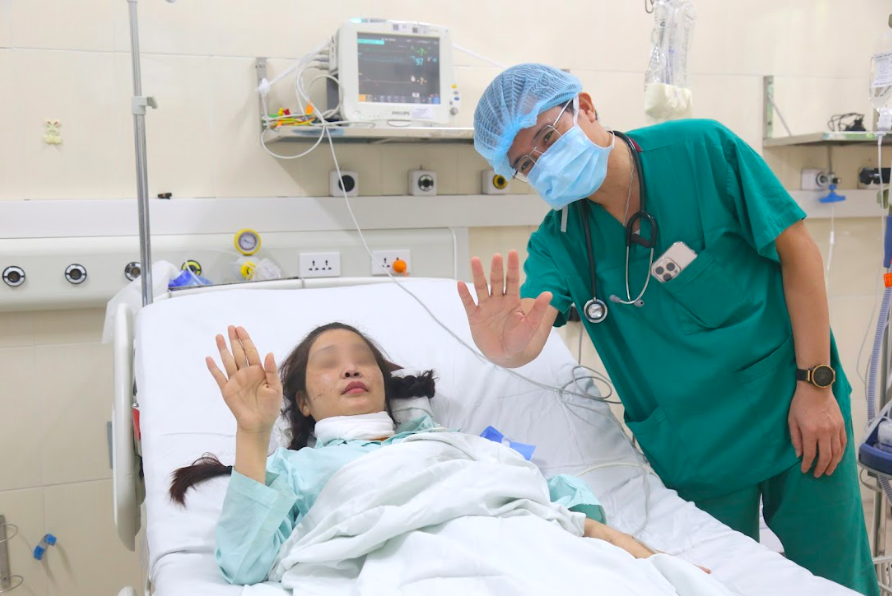The patient, suffering from Eisenmenger syndrome, irreversible right ventricular failure, and severe tricuspid regurgitation secondary to atrial septal defect, had received treatment in 2011. However, due to inconsistent follow-up care and medication adherence, her condition deteriorated, leading to a critical prognosis.
"The patient required a simultaneous heart and lung transplant despite not having sufficient time for nutritional support and the donor lungs being infected with Acinetobacter baummani and larger than the recipient's chest cavity," Dr. Duong Duc Hung, Director of Viet Duc Hospital, stated on the morning of 13/8.
Three weeks prior, upon receiving organs from a 34-year-old brain-dead donor, the doctors decided to perform the combined heart and lung transplant.
The 7-hour operation involved extracorporeal circulation. The surgical team reduced the size of both lungs for a proper fit and connected the two main bronchi instead of the trachea, deviating from the traditional method to ensure better blood supply to the anastomosis.
The biggest post-operative challenge was balancing immunosuppressants. The patient needed a high dosage to prevent rejection, but this increased the risk of infection from the multidrug-resistant bacteria in the donor lungs. The doctors utilized nearly 40 medications, combined with hemofiltration to treat kidney failure and adjusted antibiotics to protect kidney function.
The patient also received enhanced nutrition intravenously and through the digestive system, along with lung hygiene through tracheostomy, bronchoscopic suctioning, and rehabilitation exercises. Currently, her cardiopulmonary function is showing positive recovery and remains under close monitoring.
Dr. Pham Huu Lu, Deputy Head of the Department of Cardiology and Thoracic Surgery, stated that this transplant opens new treatment avenues for patients with end-stage heart and lung disease and affirms Vietnam's medical standing globally.
 |
The patient is stable after the heart-lung transplant. Photo: Thao My |
A combined heart-lung transplant is an advanced medical procedure that simultaneously replaces the heart and both lungs with healthy organs from a compatible donor. It serves as a last resort for individuals with end-stage heart and lung disease when all other treatments have failed.
This technique demands multidisciplinary collaboration and specialized intensive care. Globally, combined heart-lung transplants are infrequent due to the scarcity of donor organs, the complexity of the procedure, and the high risk of complications.
Common indications include complex congenital heart disease with Eisenmenger-type pulmonary hypertension, severe pulmonary hypertension leading to irreversible right heart failure, or end-stage lung disease with irreparable left heart damage. Only about 100 such procedures are performed worldwide annually.
Outcomes of combined heart-lung transplants have significantly improved due to advances in surgery and post-operative care. In the UK, the 90-day survival rate is 85%, and the one-year survival rate is 72%. Some leading centers in the US, such as Stanford Health Care, report a one-year survival rate of up to 90%. The 5-year survival rate is now around 60%, demonstrating the procedure's effectiveness in extending and improving the quality of life.
Dr. Ha Anh Duc, Director of the Department of Medical Examination and Treatment (Ministry of Health), considers this transplant a remarkable advancement, confirming Vietnam's mastery of the most challenging organ transplant techniques.
2025 marks a breakthrough year for Viet Duc Hospital in multi-organ transplantation. Since the program's inception in 2010, with an average of 8 to 10 brain-dead donors annually, the hospital has recorded 25 such donors this year. For several consecutive weeks, the hospital has performed organ transplants for a series of patients, including simultaneous two-organ transplants such as heart-liver, heart-lung, and liver-kidney. As of 12/8, Viet Duc Hospital has completed 2,478 organ transplants from living and brain-dead donors, including heart, lung, liver, and kidney transplants.
Le Nga












